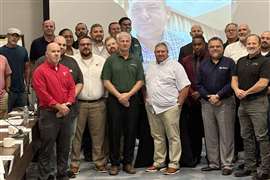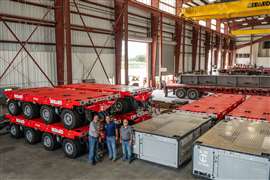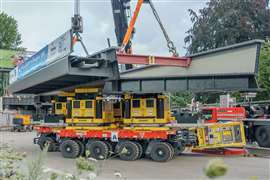Financial round table: ACT speaks to experts about obtaining financing
02 October 2012
American Cranes & Transport has assembled a round table of three financial gurus to discuss crane and transport vehicle financing. Participants include: Jay Buechler, director of Trade Finance - North America, Manitowoc Finance; Harry Fry of Harry Fry and Associates and Josh Curtis, Terex Financial Services Finance Manager – Terex Cranes USA.
It might not be the glory days of “easy money” any more, but these three chime in on how to make hay while the sun shines.
How would you characterize crane and construction equipment financing today?
Buechler: Financing availability is improving from the depths of 2009 and 2010, but it seems different than the good times that led up to 2008’s financial crash. There has been somewhat of a changing of the guard among lenders in the construction equipment space. Structures are more conservative and borrowers are facing closer scrutiny, but the smaller, local and regional players are back in the game and getting aggressive on rates if they want the deal.
Fry: [It is] different than what we have been used to (prior to 2008). Lenders today have more government regulations they have to abide by, and in turn it can make the finance process different than what customers might have experienced the last time they financed. Most companies probably have not purchased/financed equipment over the past three years because of the slowdown in the economy and their businesses. We are finding that credit decisions are still slow and methodical with extensive questions even on historical customers. And interest rates are still all over the board. However, we find that if we bring our lenders a complete package of information at the onset of credit review, the review moves much smoother and a more favorable outcome ensues.
Curtis: In a word, improving. During the global recession in late 2008 and early 2009, conventional lending literally froze. We observed various banking and commercial lending institutions freeze all lending at the end of 2008 and into the beginning of 2009. We’ve seen slow improvement from that bottoming of the market. Bank and commercial underwriters look at trends over time, and, when the gross domestic product for the world significantly contracts, this negatively affects the underwriting process. Lending institutions significantly reduce their exposure to risk, which makes it more difficult for companies to obtain financing for a capital asset. As the global economy heals and a company’s various financial metrics improve, the ability to obtain financing becomes easier. As a corporation, Terex made the strategic decision in 2007 to build Terex Financial Services (TFS) into a full-service captive. In the U.S., we do our own underwriting, servicing and financing of the capital asset. We ramped up our financing capabilities prior to the economic downturn and, by knowing the equipment, can more accurately underwrite the equipment by virtue of its underlying collateral value and revenue generating capability. Therefore, companies who would have difficulty receiving financing from traditional lending institutions during the downturn had a better chance of receiving financing through TFS.
Is credit easier to obtain than it has been? Why or why not?
Buechler: I think credit is easier to obtain than in the depths of 2009, but more difficult than in the years before the 2008 crash. While there are more players back in the game than there were, there are less than prior to the crash and the role of some of the lenders has changed. In addition, the rules of the game have changed a bit. Terms are shorter, with 10-12 year terms no longer being offered as a standard term option, and 125 percent financing (including tax and freight) is now very rare.
Fry: I don’t think credit is really easier to obtain, in the general sense of the word. There are more sources willing to offer credit but the overall credit requirements, in my opinion, have tightened. Only due to improving financial results have we seen sources more willing to provide credit. For example, for most companies their worst years are finally behind them (2009 and 2010 for most). During their tough years, many companies scaled back their operations, from selling off under-utilized equipment to laying off personnel, eliminating any expenses they could. As these businesses are starting to turnaround, their financial results are showing improvement. So when these companies apply for credit, the lenders are not as focused on the past years but looking at the current positive trends.
Curtis: It is easier to obtain financing today than a few years ago, but it’s not because the bar has been lowered by lending institutions. Rather, the economy has improved over the last two years and so too have crane rental and contractor activity. There is an appetite to lend money to companies. However, the risk standards a company must meet are much higher than they were back in 2007. Companies are in better shape today than they were in late 2008 and 2009 because the economy is in better shape, which makes it easier to obtain credit. There are certain driving factors, such as the oil and gas exploration and drilling industry, which have been catalysts for this economic recovery.
What are the biggest challenges in financing equipment for crane rental companies and contractors?
Buechler: In addition to the more conservative terms that crane borrowers now face (shorter terms, bigger down payments than in the past), there also seems to have been a change in the level of crane knowledge that lenders now have. Classic crane lenders from the past such as CIT and Citicapital, while still around in a different form as part of Wells Fargo and GE, respectively, are no longer the solid through all parts of the cycle crane lenders that they used to be, and their personnel has changed. Many veterans of the construction equipment space have moved on, and as a result, I don’t believe that crane knowledge levels of the lenders are as good as they used to be. This, along with the more intense scrutiny being applied by lenders in the underwriting process, forces crane borrowers to make sure they have a good story with all the facts ready for lenders relative to the markets they are in and how the work available in these markets can justify the acquisition of new equipment.
Fry: With business beginning to pick up again, many companies see that there is going to be a need to add equipment. The challenge is: companies might not be able to get these jobs because they don’t have the equipment and many lenders want to see that the company can afford the new purchases based on their current financials. It’s a catch-22 situation. The challenge is trying to prove to the lender that, once the company has the equipment, the revenues will follow. We are providing much more information to the credit analyst today to illustrate the company’s work story and how this new purchase will enhance their business. Customers need to be prepared with a list of work that they are turning away, jobs that are available to them if they have the equipment, etc. Help us prove to the lender how they will be repaid.
Curtis: Cranes are considered a revenue generating asset, so it’s the old question of what came first, the chicken or the egg. Does a company gain an asset in order to justify profitability, or does the company’s profitability justify the equipment purchase? It’s a balancing act. Crane rental companies and contractors must have good experience and a good business plan to aid in obtaining financing. The underwriting process will take a look at the last three years’ as well as the current year’s financial statements to determine at what point in time the company has seen a turnaround in business activity.
What are the most important considerations for a crane rental company/contractor when determining financing options?
Buechler: The financial statements of most crane rental companies and contractors were clearly impacted during the crash. When considering financing on a new crane acquisition, probably the most important thing for a borrower is to make sure they have their financial statements and other financial information (receivables agings, backlog reports, etc.) up-to-date and in order. In the new world order of post-crash lending, financing sources are examining this information even more closely in going through their underwriting process.
Fry: Most important is to forget what you did in the past with your lenders - those days are gone. With all of the new regulations, lenders have to proceed pretty much by the letter of the law for a variety of reasons.
For the customer, provide complete information that is requested of you. If you are requested to provide three years of financials and a current year interim, don’t offer less and think that will be ok. When you provide financials, take the time to prepare them in a professional manner. Know what you want to acquire and provide complete information such as the full specs, hours and miles/KM if appropriate. Know your projections on the new crane. Most of our sources want to have a clear understanding of what revenue this crane will produce and the utilization you can reasonably expect.
Keep an open mind. Is your company able to make money with the structure provided? Many customers get too focused on the interest rate. Many times a structure is provided for a loan or a lease that will meet all of the company’s cash flow needs but the interest rate might be higher than what they might have been offered in the past. As we crawl back from these last few years, companies need to keep in mind their financial position might have changed and the credit environment has changed.
Curtis: Those making the purchasing decision must talk to the company’s CFO and tax advisor as well as sales in order to balance out a capital asset acquisition with operational opportunities. There tends to be a push-pull relationship between sales and financing, but that typically averages out to a good purchasing decision. Whatever financing tool used for a piece of equipment, consider the tax and tax flow implications. Just because a company might have one financing option presented to them, doesn’t make it the best tool for the company.
Is financing easier or harder to obtain on a used piece of equipment?
Buechler: As it regards to at least our equipment, borrowers are still definitely able to obtain financing on used equipment. With demand for equipment increasing again, values on used equipment have moved back up as the overall volume of available used equipment has shrunk. Availability on some new equipment models is getting extended again, leading borrowers to seek out good, late model used equipment to fill the gap. Obviously, the borrower on a used piece of equipment still needs to have a decent credit profile and can expect to see somewhat shorter length terms and slightly higher interest rates on a used piece from lenders, but financing is available.
Fry: Age of equipment is an integral part of the credit decision. There are still many lenders that will not or cannot provide financing for equipment older than 10 years. Although they are strict with regard to the age of the collateral, their rates and terms are more aggressive for equipment that fits their criteria.
Curtis: The logic for any lender, and benefit to Terex Crane customers in the short, mid, and long term is that at any point a crane asset can be sold in most cases to generate both cash and a profit. Whether new or used, TFS focuses on a consultative customer approach where a financial structure is put in place that is both prudent and manageable for the customer relative to their financial goals and how they manage and measure their business. There is no difference between the underwriting process for new or used equipment. The collateral value and relative remaining usable life of the equipment, however, is different and affects the underwriting process and available financial terms. n
STAY CONNECTED


Receive the information you need when you need it through our world-leading magazines, newsletters and daily briefings.
CONNECT WITH THE TEAM











